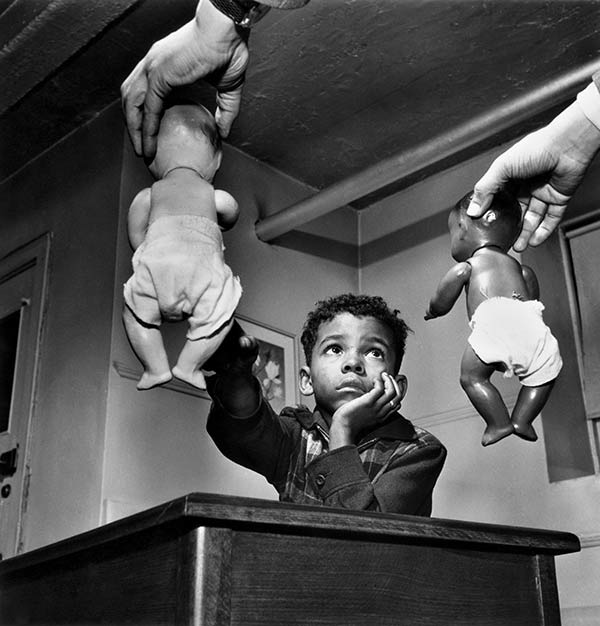Racial Innocence in Postwar America
Coinciding with Aperture magazine’s “Vision & Justice” issue, students in Sarah Lewis’s Harvard University class “Vision & Justice: The Art of Citizenship” contributed essays on the relationship between images of social unrest and landmark Supreme Court decisions. Here, Maia Silber reflects on Gordon Parks, “doll tests,” and segregation.

Gordon Parks, Untitled, Harlem, New York, 1947
© and courtesy The Gordon Parks Foundation
In the 1940s, the psychologists Dr. Kenneth Clark and Dr. Mamie Clark designed the infamous “doll tests” to study the effects of racial segregation on children. In their tests, the Clarks asked African American children to express preferences for black or white dolls. Their discovery that the majority of black children chose white dolls played an important part in the 1954 Supreme Court case Brown v. Board of Education, which ruled against segregation in public schools.
Since Brown v. Board, the Clarks’ “doll tests” have become a fixture in both psychological study and popular culture. In the sixty years since Brown v. Board, journalists, talk show hosts, and amateurs have replicated the “doll tests.” They have seen the consistent results of the experiment as evidence of internalized racism that has persisted long after desegregation.
The pioneering photographer Gordon Parks documented the experiments in a 1947 series for Ebony magazine. In one image, he depicts a young boy seated alone in the experiment room. Above the boy, disembodied hands clutch the heads of two dolls. The boy points at the white one. His stoic expression confirms the tragedy of the Clarks’ experiment while complicating our understanding of its results.
The Clarks asked their audience to examine the psyche of the black child, and imagine his vulnerability and his suffering. Parks facilitates this intimate exchange by cropping his image closely—even uncomfortably—around the boy. He positions the viewer behind the pair of disembodied hands. They are the actual hands of the experimenter and the symbolic hands of the system that forces black children to make impossible choices every day. They become our hands, too. We are no longer disinterested observers but direct actors.
Forced into this role, we confront the boy’s suffering, and his vulnerability, but also something more. The boy’s left hand, resting under his chin, draws our attention to his expressive eyes. Those eyes do not look at the white doll. Instead, the boy seems to gaze back into the experimenter’s eyes. His expression suggests neither despair nor defiance, but rather recognition of his impossible and tragic role.
In her book Racial Innocence: Performing American Childhood from Slavery to Civil Rights (2011), Robin Bernstein offers a different interpretation of the “doll tests.” Tracing a century-long history of children’s play, Bernstein argues that cultural scripts of both servitude and violence informed play with black dolls. Bernstein thus sees children’s choice of the white doll not as tacit acceptance of white superiority, but as conscious rejection of those demeaning play-acts. Their agency emerges not in defiance, but in compliance. By responding to the “doll tests” precisely as the Clarks expected them too, the children enacted their own form of resistance.
The Clarks constructed a performance of black childhood innocence, and black children, Parks suggests, understood their role in this performance. The boy appears to know that by pointing, he becomes both scientific evidence and legal testimony. A representative of childhood experience, he was asked to bear so much more than a child ever should.
Maia Silber studies history and literature at Harvard University.






















